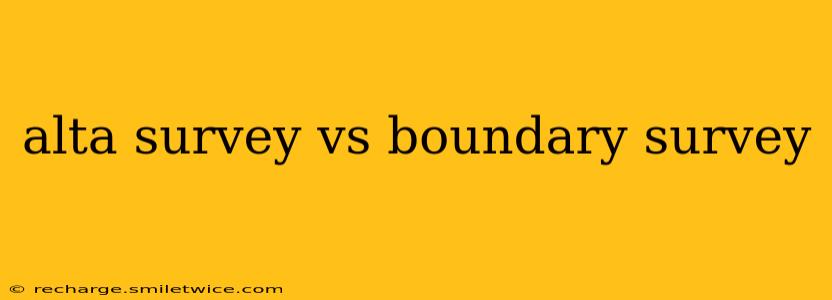Choosing the right type of land survey is crucial for various real estate transactions and construction projects. Two common types are Alta surveys and boundary surveys. While both involve determining property lines, they serve different purposes and have distinct characteristics. This comprehensive guide will clarify the key differences between Alta surveys and boundary surveys, helping you understand which one best suits your needs.
What is an Alta Survey?
An Alta survey, officially known as an ALTA/ACSM Land Title Survey, is a comprehensive land survey that goes beyond simply identifying property boundaries. It's specifically designed to meet the requirements of the American Land Title Association (ALTA) and the National Society of Professional Surveyors (NSPS). These surveys are typically required by lenders and title insurance companies to ensure the property's boundaries and any potential encroachments are accurately depicted before a loan is finalized or a title insurance policy is issued.
Key features of an Alta Survey include:
- Detailed boundary lines: Precisely locates and depicts property lines, including easements, rights-of-way, and other boundary features.
- Improvements: Shows the location of all improvements on the property, such as buildings, fences, driveways, and other structures. This is crucial for identifying potential encroachments.
- Encroachments: Clearly identifies any encroachments onto or from the property, whether it’s a neighbor's fence or utility lines.
- Easements and rights-of-way: Documents any easements or rights-of-way that affect the property.
- Surveyor's certification: Includes a detailed certification from a licensed surveyor, affirming the accuracy and completeness of the survey.
- Specific requirements: Follows the specific requirements outlined in the ALTA/ACSM Land Title Survey standards.
What is a Boundary Survey?
A boundary survey focuses primarily on establishing the precise location of a property's boundaries. While it may include some information about improvements, its main objective is to define the legal limits of the property. This type of survey is often required for various purposes, including:
- Property line disputes: Resolving disagreements about property boundaries between neighboring landowners.
- Property division: Establishing boundaries when a property is subdivided or partitioned.
- Construction projects: Determining property limits before beginning construction to avoid encroachments.
- Real estate transactions: Providing a basic understanding of property boundaries during the buying or selling process.
Key features of a Boundary Survey:
- Property boundary determination: Primarily focuses on defining the property's legal boundaries.
- Less detail on improvements: May show some improvements, but usually not as comprehensively as an Alta survey.
- May not include encroachments: Depending on the purpose, it might not detail encroachments as meticulously as an Alta survey.
- Simpler certification: The certification may be less detailed than that of an Alta survey.
Alta Survey vs. Boundary Survey: A Comparison Table
| Feature | Alta Survey | Boundary Survey |
|---|---|---|
| Purpose | Primarily for title insurance and lenders | Primarily for boundary determination |
| Detail | Highly detailed, comprehensive | Less detailed, focused on boundaries |
| Improvements | Detailed depiction of all improvements | Limited depiction of improvements |
| Encroachments | Clearly identifies and documents encroachments | May or may not identify encroachments |
| Easements | Documents easements and rights-of-way | May or may not document easements |
| Certification | Detailed and comprehensive certification | Less detailed certification |
| Cost | Generally more expensive | Generally less expensive |
What are the common questions about Alta and Boundary Surveys?
What is the difference between a boundary survey and a location survey?
While similar, a location survey often focuses on the location of specific features or improvements on the property, rather than the overall boundaries. A boundary survey defines the property lines themselves. A boundary survey can include elements of a location survey if needed.
Do I need an ALTA survey for every real estate transaction?
Not necessarily. An ALTA survey is typically required by lenders and title companies for high-value properties or complex transactions. For simpler transactions, a boundary survey might suffice.
Which survey is more expensive, an Alta or a Boundary Survey?
Alta surveys are generally more expensive due to their greater scope, detail, and stringent requirements.
Can a boundary survey be used in place of an ALTA survey?
Not usually. An ALTA survey meets specific requirements needed for title insurance and lender approval, which a boundary survey might not fulfill.
Conclusion
Choosing between an Alta survey and a boundary survey depends on your specific needs and the purpose of the survey. If you require a comprehensive survey for a significant real estate transaction involving a lender or title insurance company, an Alta survey is necessary. For simpler situations where the primary goal is establishing property boundaries, a boundary survey might be sufficient. Consulting with a licensed surveyor is highly recommended to determine which type of survey is appropriate for your project.
